I have a cast iron toilet waste pipe and I have just fitted a new toilet. How can I connect my new plastic waste pipe to my old cast iron pipe? This is a question we get asked a lot.
Traditionally cast iron was used for a whole host of applications including gates and railings, barriers, seating, ornamental structures and also plumbing including foul waste removal (soil pipe) and guttering.
Today PVC pipe is the go-to choice for plumbing and if you are looking at changing your guttering, changing a toilet or undertaking other major plumbing work you may discover that you need to connect into a cast iron pipe or soil pipe, find out how below.
Why are Some Drainage and Plumbing Pipes Cast Iron?
As we have mentioned above, in years gone by, cast iron was the go-to material to use to form all manner of structures and pipework.
This was mainly due to the fact that, as a material and when it is properly prepared and installed, it is extremely long lasting, very, very strong, tough and hard to damage. All of these factors make it ideal to use for things like pipework, especially where it’s exposed on the outside of a building, hence a soil pipe or guttering.
So, if your property is old enough e.g. dating back before the second world war (when plastic processing was refined to the point it was then cheaper than using iron) then the chances are that it may feature some cast iron somewhere.
With this in mind, back when cast iron established itself as the material to use for these tasks, plastic in it’s modern form where it can be used for jobs such as these had not been developed as yet so wasn’t even a consideration.
Today it is highly unlikely that you will encounter any cast iron on a property unless it’s a listed property and as part of the conservation order it states that all fixtures, fittings etc. must be correct for the period.
If this applies to you then it’s still more than possible to obtain cast iron pipework as there are numerous companies that produce it for this reason and as it’s more modern its much more refined and easier to work with. For example traditional seals were often made of lead whereas now they are made of rubber and create a much better seal.
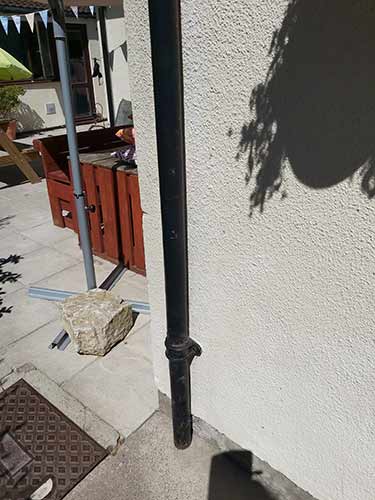
Traditional cast iron guttering down pipe
Can You Remove Cast Iron Pipes?
As a short answer, yes you certainly can remove old cast iron pipework and replace it with more modern PVC pipework.
However the only real reason you would want to remove any existing cast iron pipework would be if you are changing the layout of any plumbing within your home or if it was damaged.
If neither of these are the case then in all honesty there isn’t much point in undertaking the work, it would really be a waste of time and money as if it’s in good condition there is no reason why it won’t last for many years.
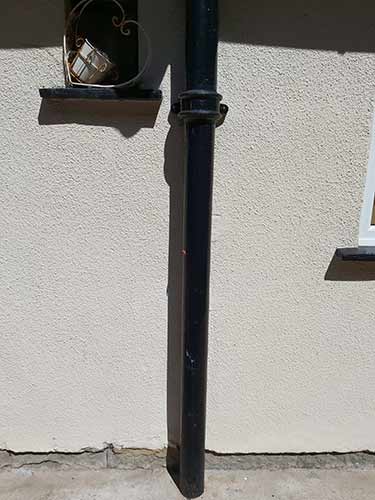
Good condition cast iron soil pipe
Options For Connecting to Old Cast Iron Drainage Pipes
If you do need to remove any cast iron pipework on your property, removing all of the above ground pipes is a fairly easy job, however once they go underground this is a much trickier job.
As many over the years had encountered this problem some clever individuals came up with some innovative products that allowed you to join your new pipework at the point the old cast iron pipework disappeared underground, here are some of the best ones.
Note: All of the options below are non-pressurised fittings so they cannot be used if the pipes you’re trying to join are pressurised in any way.
110mm Universal Pipe Connector/SP140 Connector
The 110mm universal pipe connector or SP140 connector as it can also be called does exactly what it says on the tin – it’s a connector that’s used to connect new 110mm PVC soil pipes to a range of older pipes including cast iron and clay.
Once the clay or cast iron pipe has been cut, the finned end of the connector is then pushed down into the cut pipe leaving a modern 110mm push-fit socket to connect your new PVC soil pipework to.
As long as the finned end of the connector fits into the pipe this type of adaptor provides a firm and solid fixing for you new pipework and also creates a great seal preventing any leakage of smells.
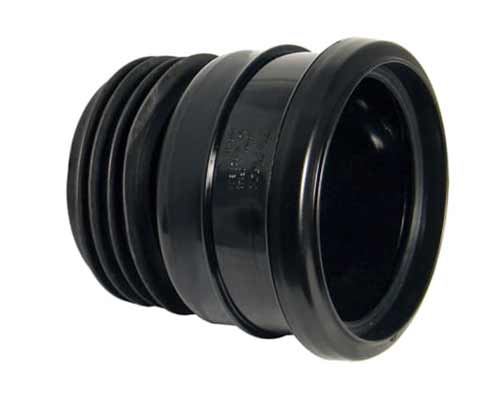
Universal pipe connector or SP140 connector
Flexible Pipe Connector
The flexible pipe connector was traditionally the way to go whenever you wanted to connect newer 110mm plastic pipework to older cast iron or clay pipes.
In essence it’s a flexible rubber adaptor that slots over your cut iron or clay pipe and is then held in place using a large diameter compression clip or hose clip.
Finally your new PVC pipework is then pushed into the top of the adaptor and is also secured in place using a hose clip.
These connectors are very effective and certainly do the job and they can also be used to connect pipework underground, however when used over ground they are a little unsightly.
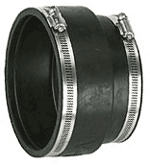
Flexible pipe connector
Timesaver Coupling
The time saving coupling is again a form of pipe joiner and as with the others above is also stepped for joining older diameter pipework to newer 110mm PVC pipes.
The Timesaver coupling is one of the oldest types of pipe couplings first appearing on the market in the early 70’s and has remained a proven for of pipe joining since then.
Due to the construction materials used it is pretty much the strongest and most secure connection available, especially the version developed for use underground and due to this is the go-to choice for many when joining pipes underground.
The Timesaver coupling is available in 2 versions mostly, one for use over ground and the other for use under it.
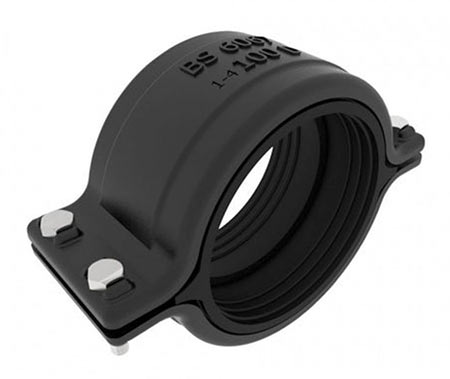
Timesaver coupling for use over and underground
How to Connect to Cast Iron Drainage Pipes
As we have now looked at why you might need to connect to cast iron pipework it’s time to look at how it’s actually done.
Isolate any Water or Waste Flow
Before you start anything make sure that once you start cutting and removing the existing pipework no water or more importantly, if you’re changing a soil pipe, foul waste will flow and pour out of the cut you’ve made and cover you!
Cover over any toilets that connect to the soil pipe you’re working on and place notes on them signaling they’re out of order.
If you’re changing guttering this shouldn’t be a problem, just don’t do it when it’s raining.
Cut Away Existing Pipe
The next job is to cut the existing cast iron clay pipe so that it can be removed. When joining to a section of existing pipe at floor level, cut the existing pipe roughly 4 – 6 inches above ground level so that you have a nice amount of existing material to fix to.
The best tools to use for this is either an angle grinder or reciprocating saw with a metal blade. Before you start cutting mark a level cutting line all the way around the pipe to ensure your cut is straight.
Before cutting anything ensure that you are wearing old clothes, a mask, gloves, eye protection and face protection. Whether cutting iron or clay, dust and debris will fly everywhere so you need to protect yourself.
Almost always the cast iron pipe is against the wall with only a very small gap behind it making it impossible to get a grinder in to finalise the cut. In these instances it’s best to cut through horizontally as far as you can and then cut a wedge out above it.
This way you can then access the rear and finalise your cut nice and straight.
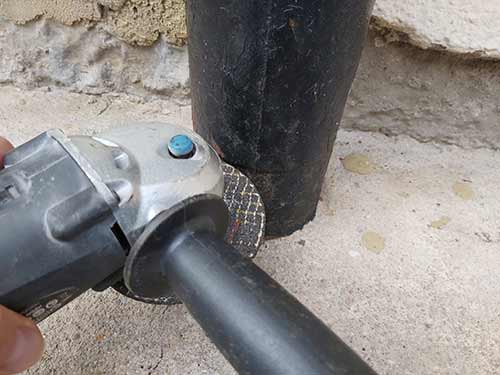
Cutting old cast iron soil pipe using a grinder
Note: Cutting cast iron and clay isn’t too bad aside from the dust mentioned above, however some older soil pipes can be made of asbestos and if you are in any doubt get your pipe tested by one of the many asbestos testing services online before you do anything!
Remove Old Cast Iron Pipework
Once the base is cut then the next job is to remove the remaining pipework from the wall. Inmost cases this will just be a case of removing any brackets holding it in place and then pulling it away.
In terms of the brackets, some might be screwed but others may have pins hammered in. In either case they can be tough to get out and ultimately might need to be levered away using a pry bar.
Additionally, cast iron pipework is very heavy so you may need to enlist some help to maneuver it depending on how much there is.
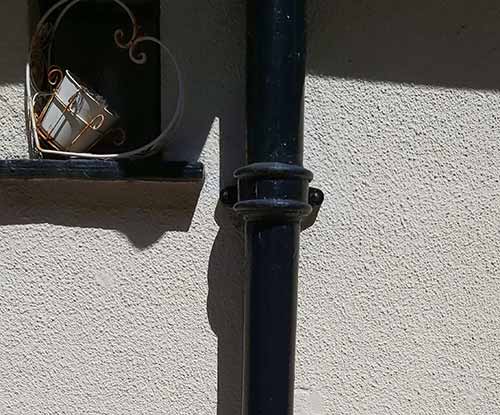
Cast iron bracket to be levered off of wall
Fix Pipe Connector to Cast Iron
With the old pipework out the way, depending on what type of connector you’re using, place the connector either in (universal connector) the top of the pipe tail protruding out of the ground or over the top if using Timesaver or flexible pipe connector.
Push the connector down firmly into or over the pipe tail and make sure it’s sitting correctly. If using flexible connector, use the correct sized socket to fully tighten.
If using a Timesaver then simply put it in place and tighten it slightly but not fully as you’ll need to get the new pipework in place first before fully tightening.
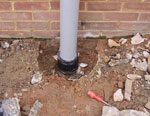
Flexible connector down on top existing cut soil pipe
Connect up new Pipework
With your connector in place the final task now is to get the new pipework in place.
To do so simply push the new pipe into the top of the connector. If using a universal connector put some washing up liquid around the seal first as this will help the pipe slip in.
If you’re using a flexible connector wiggle the pipe down in. Again if it’s tight use some washing up liquid. If using a Timesaver carefully inset the pipe down in ensuring you don’t damage the seal.
Whichever connector you’re using, once the pipe is in place get it level and get a bracket on the wall to hold it.
Once firm and if needed, tighten the connector up fully. The pipe should now be fully sealed and water tight so now the remaining pipework can be fixed in place.
Once it is, get some water flowing and ensure there are no leaks.
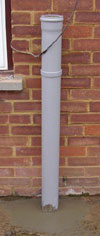
New soil pipe connected to existing pipe
Other Options for Removing Cast Iron Pipes
In terms of other options available to you, the other method and in all honesty the correct procedure to take is to dig up all of the old cast iron pipework and fully replace it with PVC.
Regardless of how much pipe needs to be replaced this is a big job and probably involves breaking up concrete, digging up driveways, lawns and also maybe gardens – in essence a lot of disruption.
Although this is technically the correct path to take as you can appreciate it’s a lot of hassle and expense and if you can simply join to the old pipe using a suitable connector this is many ways will probably be the best way to go.
Connecting new PVC plastic pipe to cast iron pipe is a pretty straight forward job and given the alternative, one that appeals much more I’m sure!
If you want to see how to replace the whole soil pipe in plastic, see our soil and vent project here.

